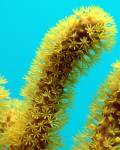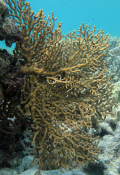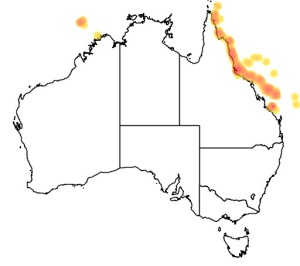�
�

©Anne Hoggett: Isis hippuris with polyps extended and partly retracted at Big Vicki's Reef, Lizard Island.

©Anne Hoggett: Isis hippuris colonies with polyps extended at rear and one with polyps fully retracted in foreground at Big Vicki's Reef, Lizard Island.
�
���
Isis hippuris

©Anne Hoggett: Isis hippuris with polyps extended and partly retracted at Big Vicki's Reef, Lizard Island.

©Anne Hoggett: Isis hippuris colonies with polyps extended at rear and one with polyps fully retracted in foreground at Big Vicki's Reef, Lizard Island.
Kingdom
Animalia
Phylum
Cnidaria
Class
Anthozoa
Order
Malacalcyonacea
Family
Isididae
Genus
Isis
Species
Isis hippuris
Colours
Distinguishing features
Isis hippuris is the sole member of the genus, and it has an Indo-Pacific distribution. Colonies consist of smoothly branched structures arising from a solid base. Polyps are monomorphic and completely retractile, leaving the branches smooth. Colonies are usually a yellowish brown, but bright yellow, green, and brown specimens are seen.
Size
- Size data has not been obtained.
Synonyms
Distribution
Distribution and habitat preferences
Sheltered back reef and lagoonal habitats.
Can be found in most reef habitats around Lizard Island, although is more common in sheltered, clear lagoonal environments.
Behaviour
Isis hippuris is known to have high concentrations of toxic organic compounds including poly-oxygenated sterols, which deter predators and also inhibit settlement and competition from other benthic organisms.
Web resources
References
References that assist with identification
- Fabricius, K. and P. Alderslade (2001). in: Soft corals and sea fans: a comprehensive guide to the tropical shallow water genera of the central-west Pacific, the Indian Ocean and the Red Sea. Australian Institute of Marine Science, Townsville.
Other references
- Fabricius, K.E. (1997). Soft coral abundance on the central Great Barrier Reef: effects of Acanthaster planci, space availability, and aspects of the physical environment, Coral Reefs, 16(3): 159-167.
- González, N., M.A. Barral, J. Rodríguez and C. Jiménez (2001). New cytotoxic steroids from the gorgonian Isis hippuris: structure–activity studies, Tetrahedron, 57(16).
- View all references




